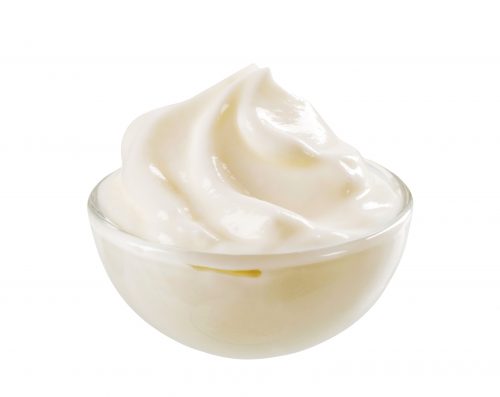
Flavoured yoghurt can be a snack or a treat, part of breakfast or added to smoothies. But is it good for us? Here’s how to choose the best type for you.
What’s available?
The array of flavours available in yoghurt is vast and delicious. There are also many varieties, such as traditional yoghurt, pourable, Greek, natural, organic, lactose free and full cream, plus non-dairy options such as soy and coconut yoghurt.
Saturated fat
Foods and drinks made from full-fat milk can be high in saturated fat, and consuming a lot can add much more saturated fat to your diet than is good for you. There is a strong link between diets high in saturated fats and heart disease. There is some evidence that the effect of saturated fat in yoghurt on heart health could be counterbalanced by the protein, calcium or some of the other components in it. But much more research is needed around this. For everyday use, we recommend choosing flavoured yoghurt with 1.3g or less saturated fat per 100g.
Gourmet yoghurts are usually higher in saturated fat, but we often use smaller amounts and as a substitution for products that are even higher in saturated fat, such as cream or ice cream. For a treat or dessert yoghurt we recommend choosing flavoured yoghurt with 3.5g or less saturated fat per 100g and using a small amount.
Sugars
Yoghurt contains lactose, the main sugar in milk. Many flavoured yoghurts also contain natural sugars from fruit as well as added or ‘free’ sugars, so some can get quite high in sugar. We recommend choosing flavoured yoghurt with 10g sugars or less per 100g.
Calcium
The recommended dietary intake for most adults is 1000mg per day, and for women over 50 and men over 70 years it is 1300mg. We recommend choosing flavoured yoghurt with 150mg calcium or more per 100g.
Energy
Some yoghurts can be higher in fats, therefore higher in kilojoules. Others may be higher in sugars which also up the kilojoules in the yoghurt. If you are watching your weight, we recommend choosing flavoured yoghurt with 400kJ or less per 100g.
Probiotics
Many yoghurts state they have probiotics, which is great. But to claim any benefit, there needs to be scientific evidence supporting this and confirmation that the yoghurt has been tested.
Coconut yoghurt
It may taste nice, but we don’t recommend coconut yoghurt or coconut-flavoured yoghurt as an everyday yoghurt because the saturated fat content is so high. For example, Zenzo coconut yoghurt has a whopping 21g saturated fat per 100g (which is less than half a cup). Based on an 8700kJ day, it’s recommended we have no more than 24g saturated fat each day.
How to choose
Use the criteria below to compare flavoured yoghurts:
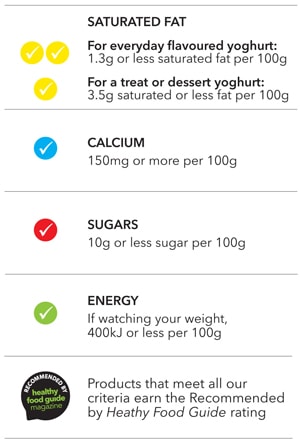
Some healthier choices we found

$3.99 per 500g pottle
Nutrition per 100g: 297kJ, 0.5g saturated fat; 8.6g sugars, 178mg calcium; 80 cents
A nice subtle vanilla flavour with a creamy texture.
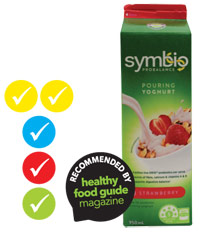
$4.99 per 950ml carton
Nutrition per 100ml: 268kJ; 0.6g saturated fat; 8.4g sugars; 188mg calcium; 53 cents
A mild strawberry flavour. Like the pouring consistency.
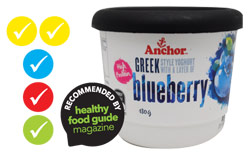
$2.49 per 180g pottle
Nutrition per 100g: 310kJ; 1g saturated fat; 7.1g sugars; 164mg calcium; $1.38
This is thick, creamy and not too sweet.
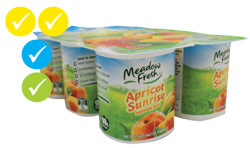
$4.29 per 6x125g pottles
Nutrition per 100g: 350kJ; 0.9g saturated fat; 10.9g sugars; 160mg calcium; 57 cents
Tastes like stewed apricots. Yum!
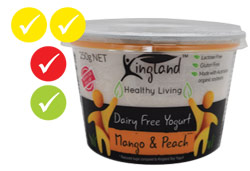
$2.99 per 250g pottle
Nutrition per 100g: 380kJ; <1g saturated fat; 4.2g sugars; 47mg calcium; $1.20
A nice flavour. One of the best soy yoghurts.
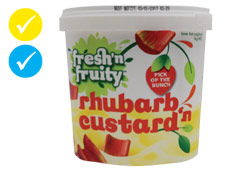
$4.49 per 1kg pottle
Nutrition per 100g: 403kJ; 1.5g saturated fat; 13g sugars; 183mg calcium; 45 cents
Loved the flavour and texture. More like a dessert. Tastes like a treat.

$4.49 per 400g pottle
Nutrition per 100g: 423kJ; 0.8g saturated fat; 10.6g sugars; calcium not stated; $1.12
Love the thick texture. Not too sweet. Rich and creamy.
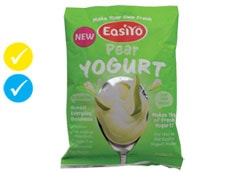
$3.49 per 1kg (when prepared)
Nutrition per 100ml: 443kJ; 2.9g saturated fat; 13.1g sugars; 151mg calcium; 35 cents
Quite sweet but good texture. More like a dessert.
Article sources and references
- Ebner S et al. 2014. Probiotics in dietary guidelines and clinical recommendations outside the European Union. World Journal of Gastroenterology. 20:16095-100https://www.ncbi.nlm.nih.gov/pmc/articles/PMC4239494/
- Gomes JMG et al. 2015 Could the beneficial effects of dietary calcium on obesity and diabetes control be mediated by changes in intestinal microbiota and integrity? British Journal of Nutrition 114:1756-65https://www.cambridge.org/core/journals/british-journal-of-nutrition/article/could-the-beneficial-effects-of-dietary-calcium-on-obesity-and-diabetes-control-be-mediated-by-changes-in-intestinal-microbiota-and-integrity/EF9A238860CE872D23F6A535A8ACBB7D
- Hae-Jeung Lee et al. 2014. Intakes of dairy products and calcium and obesity in Korean adults: Korean National Health and Nutrition Examination Surveys (KNHANES) 2007-2009. PLOS ONE 9:e99085https://www.ncbi.nlm.nih.gov/pubmed/24915202
- Huth PJ et al. 2012. Influence of dairy product and milk fat consumption on cardiovascular disease risk: A review of the evidence. Advances in Nutrition 3:266–85https://www.ncbi.nlm.nih.gov/pubmed/22585901
- National Health and Medical Research Council (Australia) & Ministry of Health (New Zealand). 2006. Nutrient Reference Values for Australia and New Zealand including Recommended Dietary Intakes. Canberra: NHMRChttps://www.nhmrc.gov.au/sites/default/files/images/nutrient-refererence-dietary-intakes.pdf
- Rice BH. 2014. Dairy and cardiovascular disease: A review of recent observational research. Current Nutrition Reports 3:130-138https://www.ncbi.nlm.nih.gov/pmc/articles/PMC4006120/
- The Heart Foundation heartfoundation.org.nz Accessed Dec 2016https://www.heartfoundation.org.nz/
www.healthyfood.com










